Despite being fairly new to AFV (armored fighting vehicle) modelling, I found myself in my element when painting the King Tiger's accessories. In essence, the 1/35 scale details covered familiar ground. As a miniature hobbyist, I am thankfully familiar with the techniques involved in painting tiny details. The initial score of photos comprise close-ups of the tank accessories starting on the left front corner, and subsequently moving clockwise around the hull to the front. After being applied to the
turret and road wheels earlier, the oil pin wash was also put on the hull in this hobby session.
 |
| Meng King Tiger work-in-progress: accessories and oil pin wash on the hull |
 |
| Woodgrain texture on the hammer handle had to be scribed using a sharp X-Acto blade |
 |
| Metal parts of the tools were weathered using Tamiya Light Sand pastel color |
Because the wood-based pioneer tools were molded as smooth plastic parts, I needed to create the wood grain texture myself if I wanted to up the realism. So what I ended up doing was to scribe the wood fiber patterns on the axe and hammer handles using an
X-Acto knife. Now there are specialized hobby tools for use in engraving lines and patterns on plastic parts. Unfortunately I didn't have any scribing tools at hand to make the wood grain patterns, but luckily the simple hobby knife worked just as good for my intended purposes. And I was ecstatic at how the wood handles turned out.
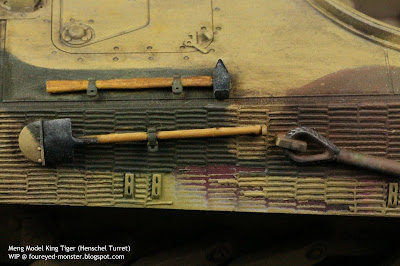 |
| Red oxide showing through the hull damage is the actual color of the molded plastic part |
 |
| Even plastic molded tow cables can approach realism with the help of some painting and dry-brushing |
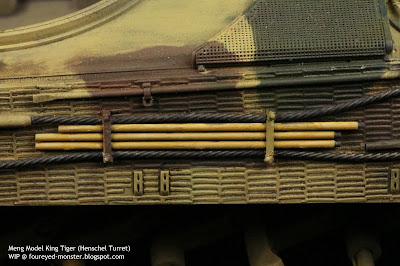 |
| These light brown wooden rods were presumably used to clean the King Tiger's gun barrel |
In the closeups you can also see the effect of the oil pin washes. Results were especially pronounced for the zimmerit coating and rivets and such. Having the oil wash flow into every nooks and cranny of the hull surface adds depth provided any excess wash is wiped off. As with the turret, extra care was taken to prevent the oil wash from pooling at the zimmerit surface. If that was allowed to happen then the whole tank would have taken an unwanted darker shade in the overall color scheme.
 |
| Nestled within the curvature of the tow cable, the hand crank retains the colors of the camouflage pattern |
 |
| Extreme close-up of the wire cutter, secured on the rear hull surface, and resting amidst the engine grilles |
When it came to the exhaust pipes at the rear end of the King Tiger hull, less was more. Although many a modeler has gone the route of heavily rusted exhaust pipes, I decided to go the other way. Of course having the exhaust pipes encased in rust is still historical accurate, just not in all cases. Many factors come into play such as operating condition and weather. And even with access to historical photos of
Tank 124 of Pz.Abt. 505 as well as photos of finished works by expert modelers, I still can't really tell for sure the exact condition of the exhaust pipes as they were during the war.
 |
| Soot adorns the outtake of the King Tiger's rear exhaust pipes |
 |
| For a tank in operational condition, rust on the exhaust pipes were kept to a minimum |
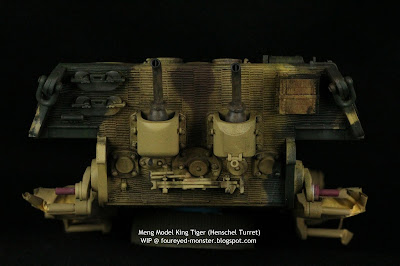 |
| Wide-angled view of the King Tiger rear hull section sans road wheels and tracks |
Cognizant of the near impossibility in determining the exact condition of the exhaust pipes in a historical context, I decided to recreate a 'mildly stressed condition'. This translates into an exhaust system that's in fairly good condition, has minimal rust, and is covered by soot at the outtakes. One of my strengths, which doubles up as a weaknesses, is the need to extensively research how something should look like before trying to recreate this realism via art. Thus any satisfaction I feel when pulling off such an attempt is dampened somewhat by the lengthy time invested in the effort.
 |
| Depending on the operating environment, the tank's exhaust pipes are sometimes depicted as extensively rusted |
 |
| Close-up view of the exhaust pipe shows both soot and traces of rust |
One school of thought among modelers is that the plastic tow cable parts provided in most tank model kits should always be replaced by metal equivalents. For sure the metal-based tow cable parts do provide flexibility in how you want to pose it in a vignette or diorama. However, in terms of visual realism I believe there's little difference in using either the plastic parts or their metal equivalents. The end result, I feel, will always be determined by how it's painted and weathered, not by the material the tow cable part is molded from. It's more important that the said part is sculpted well.
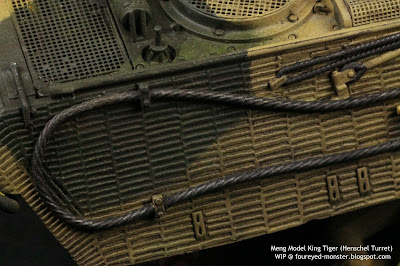 |
| For realism sake, the tow cables displayed traces of exposed metal and old rust |
 |
| More barrel rods, this time on the right side of the hull |
 |
| Thinner tow cables lie alongside thicker ones below it |
In any case, the tow cables were painted and weathered to show the consequences of a lengthy exposure of bare metal to air. To that effect, dark rust and metallic iron formed the predominant hues of the cables on each side of the King Tiger hull. Apart from the axe, hammer and spade, the other metal-based tool was the hand crank, located on the rear left corner (
see seventh photo from the top). This tool took on the color scheme of the three tone camouflage to recreate the idea the hand crank was still in place in its brackets on the hull when the camouflage pattern was painted on the tank.
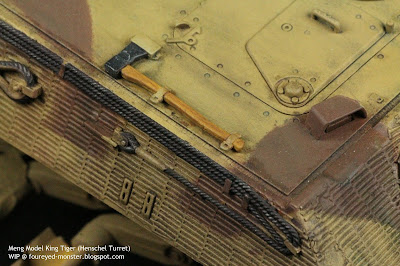 |
| Micro-chipping has yet to be carried out on the hull surface proper |
 |
| Woodgrain on the axe handle was created in a similar way to those found on the hammer |
 |
| Wide-angled view of the King Tiger front hull section sans road wheels and tracks |
Painting and weathering of the tank accessories were carried out using
Vallejo Model Color acrylic paints,
Tamiya Weathering Master pastels and
Citadel washes and metallic paints. Admittedly, I'm not working from any actual historical color references of these hull accessories. It's definitely a worthy endeavor to try and mimic historical color schemes, and I respect modelers that try to do this. But since it's something I cannot achieve with complete accuracy, I am able to let go of the need for historical realism. This is no mean feat with my perfectionist and obsessive compulsive tendencies.
 |
| Materials used: Vallejo Model Color acrylics, Tamiya weathering pastels, and Citadel washes and metallics |
For a perspective on the details as they sit on the tank hull we'll have to zoom out and see the accessories as they are on the King Tiger hull. Below are a series of photos showing the work-in-progress tank hull together with the various pioneer tools and tow cables. Trivia time. As I understand it, pioneer tools are engineering equipment attached to AFVs for use in assisting tank operations.
 |
| Zoomed out, three quarter view of the King Tiger hull sans road wheels and tracks |
 |
| Left sided view of the hull showcasing the hammer, spade, barrel rods, hand crank and tow cable |
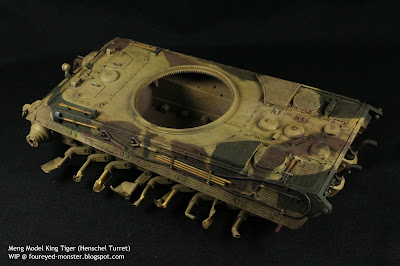 |
| Even without its turret, road wheels and tracks, the King Tiger hull looks pretty impressive |
 |
| So much work has been put into the hull but I've barely scratched the surface of what needs to be done |
 |
| Right sided view of the hull showcasing the axe, barrel rods, and tow cables |
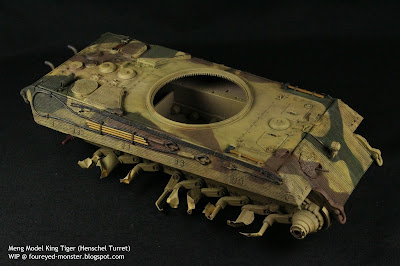 |
| A lot of weathering remains to be done on the hull e.g. micro-paint chips, dust, dirt, stains, etc. |
A weird thing about this hobby is how much it invigorates me when results begin to look like the real thing. Therein lies the problem for most of my extended periods of hobby malaise. Until results begin to take hold, I frequently find it laborious to maintain the inspiration and motivation to continue working on a project. In short, it's all in my head. Lucky for me, the
Meng Model King Tiger project has reached the said critical tipping point. From here on, I should hope paint job and weathering successes, however minor, will continue to feed the urge to finish this project. One day. Soonish.

















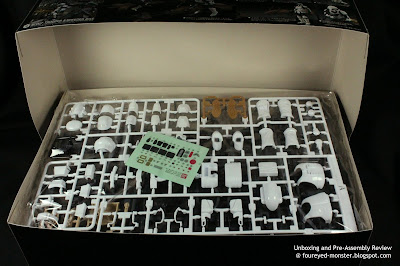
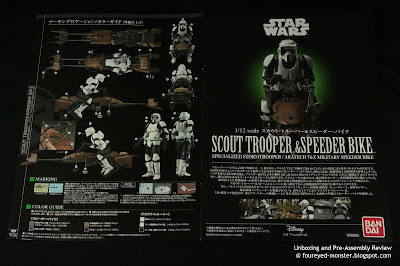





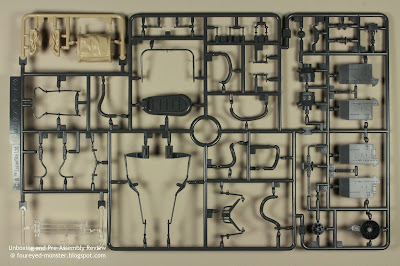

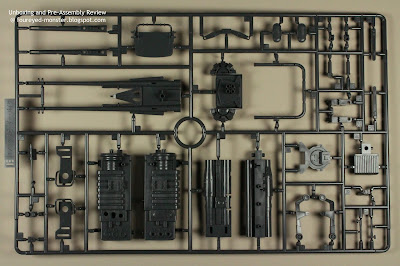

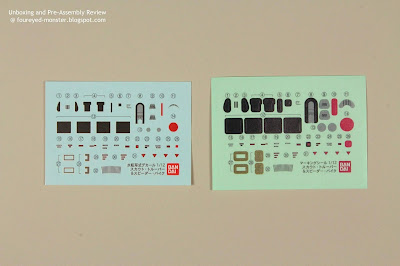
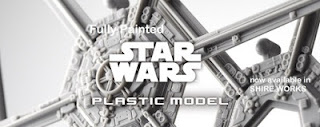

.jpg)

























